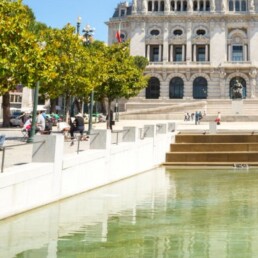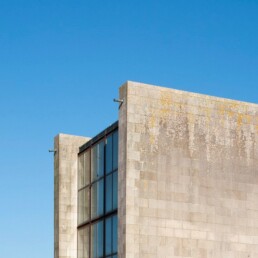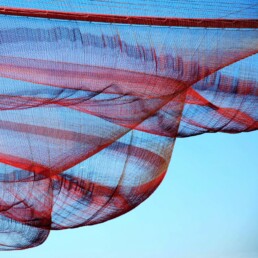Tagline
Reispas voor Porto
Porto is de tweede grootste stad van Portugal waar je ondergedompeld wordt in een ontspannen, zuiderse sfeer. Wandel door de nauwe, steile steegjes in de Ribeira wijk en snuif het unieke karakter op van de portostad. De kleurrijke authentieke huizen met typische ‘azulejos’, de open pleinen en de prachtige Dom Luisbrug behoren niet voor niets tot het Unesco-werelderfgoed.
Praktische info en tips
xxx
ALIADOS
De boulevard van Aliados wordt ook wel eens het kloppende hart van het centrum van Porto genoemd. De avenue is omringd door prachtige historische gebouwen zoals verschillende banken, het stadhuis en Hotel Aliados. De Aliados in in zijn huidige indrukwekkende staat als “statement” locatie sinds 1916. Het stadhuis (Câmara Municipal) dat zich aan het uiteinde van de boulevard bevindt, heeft een indrukwekkende klokkentoren van zo’n 70 meter hoog. Een leuk extraatje is dat zich hier zogezegd “de mooiste” McDonalds ter wereld bevindt.
The promenade of Aliados is also known as the beating heart of the centre of Porto. The avenue is surrounded by beautiful historic buildings such as several banks, the town hall and Hotel Aliados. The Aliados in its present impressive state as a statement location since 1916. The town hall (Câmara Municipal) at the end of the promenade has an impressive bell tower of about 70 meters high. A nice extra is that here you will find “the most beautiful” McDonalds in the world.
CITY HALL
Het stadhuis van Porto is in 1955 gebouwd door de architect Antonio Correia Da Silva in samewerking met architect Carlos Ramos. Het heeft een klokkentoren van 70m hoog en binnenin 2 patios. Het 6 verdieping hoge gebouw heeft een gevel gemaakt van graniet en marmer, met stambeelden, die verwijzen naar dagelijkse activiteiten van Porto, in verwerkt gemaakt door de kunstenaars José Sousa, Caldas en Henrique Moreira. Binnenin bevat het gebouw prachtige plafondschilderingen van het wapenschild en de patroonheilige van Porto, uit de romantische periode.
Porto Town Hall was built in 1955 by the architect Antonio Correia Da Silva in collaboration with the architect Carlos Ramos. It has a bell tower of 70m high and inside 2 patios. The 6-storey building has a facade made of granite and marble, with tribal statues referring to daily activities of Porto, in incorporation by the artists José Sousa, Caldas and Henrique Moreira. Inside, the building contains beautiful ceiling paintings of the coat of arms and patron saint of Porto, from the romantic period.
CASA DA CAMARA (CASA DOS 24)
De Casa Da Camara, dat zich naast de Se kathedraal bevindt en grenst aan de muren rond de heuvel van de kathedraal, is oorspronkelijk gebouwd in de 15e eeuw. Toen functioneerde het als stadhuis en de eerste zetel van de gemeente. De 24 vertegenwoordigers van Porto kwamen hier samen. Vandaar ook wel de naam Casa Dos 24. In 1875 tijdens de zware branden die in Porto plaatsvonden werd het gebouw hard beschadigd. Architect Fernando Távora bouwde het opnieuw op in de jaren 2000 met respect voor de originele afmetingen. Vandaag de dag functioneert het als toeristisch kantoor.
The Casa Da Camara, located next to the Se cathedral and adjacent to the walls around the cathedral hill, was originally built in the 15th century. At that time it functioned as the town hall and the first seat of the municipality. The 24 representatives of Porto met here. Hence the name Casa Dos 24. In 1875 during the heavy fires that took place in Porto, the building was badly damaged. Architect Fernando Távora rebuilt it in the 2000s with respect for its original dimensions. Today it functions as a tourist office.
SHE CHANGES
Het kunstwerk She Changes is in 2005 ontworpen door Janet Echelman, en is ondertussen het grafisch symbool van de stad Porto. Het is een gigantisch 3-dimensionaal net dat tot 27 meter hoog van de grond hangt aan 3 stalen palen. Het werk bestaat uit verschillende lagen allemaal uit zacht en flexibel materiaal die vloeiend bewegen door de wind. Dit creëert bewegende tekeningen van schaduw op de grond, die de choreografie van de wind benadrukken. Het is voornamelijke bedoeld om de geschiedenis van de stad als industrieel en vissers centrum uit te lichten, maar de bewoners geven er graag hun eigen betekenis aan, van vissersnetten en masten van boten tot de geschiedenis van de Portugese kant industrie. De palen zijn rood met wit beschilderd en staan zo voor de vele vuurtorens en schoorstenen in de buurt. Het net bestaat uit 36 verschillende secties, die met verschillende dichtheden geweven zijn, en ieders met de hand aan elkaar gezet zijn om zo de gelaagdheid van het werk te bekomen.
The artwork She Changes was designed by Janet Echelman in 2005, and is now the graphic symbol of the city of Porto. It is a gigantic 3-dimensional net that hangs up to 27 meters high from the ground on 3 steel poles. The work consists of different layers, all made of soft and flexible material that moves fluently in the wind. This creates moving drawings of shadows on the ground, emphasizing the choreography of the wind. It is mainly meant to highlight the history of the city as an industrial and fishing centre, but the inhabitants like to give it their own meaning, from fishing nets and masts of boats to the history of the Portuguese lace industry. The poles are painted red and white and stand in front of the many lighthouses and chimneys in the area. The net consists of 36 different sections, woven at different densities, each of which has been put together by hand in order to achieve the layering of the work.
SÉ CATHEDRAL
De Sé kathedraal is één van de meest populaire toeristische attracties van de stad en ondertussen een nationaal monument. De bouwwerken ervan zijn begonnen in de twaalfde eeuw maar het is over de eeuwen heen een mix geworden van verschillende bouwstijlen. Aan de kathedraal bevind zich een klooster dat samen met één van de kapellen voornamelijk een gotische bouwstijl heeft, het grootste deel van de kathedraal is barok maar de gevel en het schip dan weer Romaans. Je kan de kathedraal zelf gratis bezoeken en voor €3 kan je ook in het klooster een kijkje gaan nemen.
The Sé Cathedral is one of the city’s most popular tourist attractions and is now a national monument. Its construction began in the twelfth century but over the centuries it has become a mix of different architectural styles. At the cathedral there is a monastery which, together with one of the chapels, mainly has a Gothic architectural style, most of the cathedral is baroque but the facade and the nave are Romanesque. You can visit the cathedral for free and for €3 you can also have a look in the monastery.





